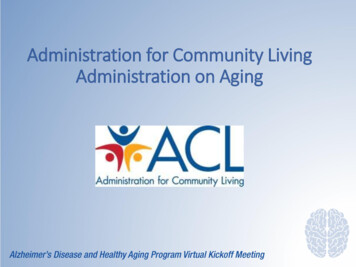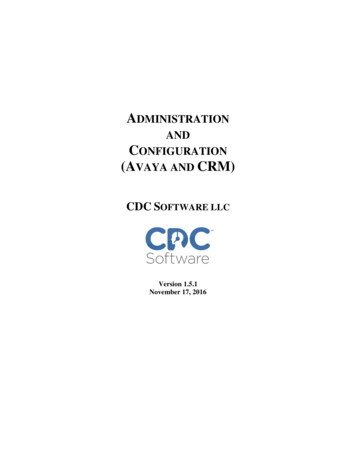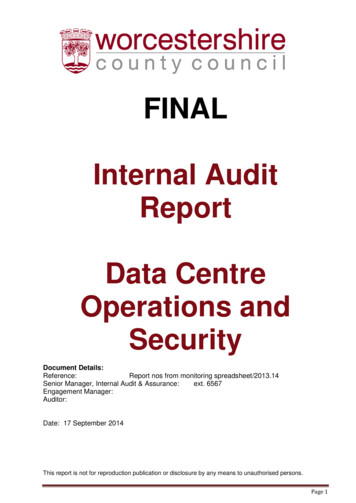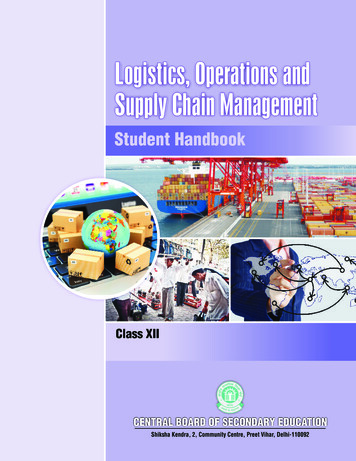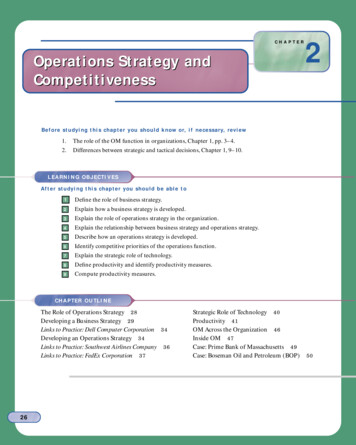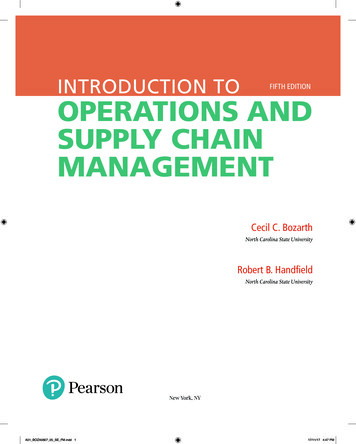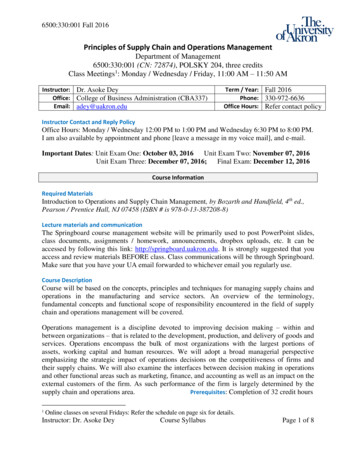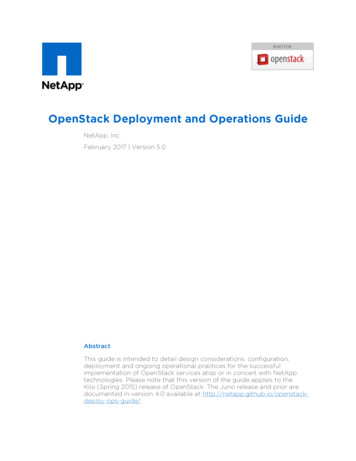
Transcription
Monterey Bay National Marine Sanctuary – Proposed Action PlanPart IV – Operations and AdministrationStaffingFacilitiesSanctuary Advisory CouncilVolunteer ProgramAdministrative InitiativesBoat OperationsDive OperationsAircraft OperationsPermit ProgramMinor Regulatory ChangesMinor Boundary ShiftsInteragency Program Review
Monterey Bay National Marine Sanctuary – Proposed Action PlansOperations and AdministrationOperations and Administration Action PlanGoal StatementThe desired outcome of the Operations and Administration Action Plan is the increasedprotection of MBNMS resources and qualities, achieved with the budget and staff necessary foradequate implementation of the JMPR Action Plans.This Action Plan was developed by an internal MBNMS staff team.MBNMS Staff ContactJenny HauserIntroductionMBNMS will address operations and administration issues such as identifying staffing andinfrastructure resource needs, minor boundary and regulatory corrections, and permit-processingimprovements. Minor boundary adjustments include addressing entrances to river mouths wherethe MHWL is not clearly delineated and entrances to harbors where fixed points provide aclearer delineation than the ColReg line at harbor mouths. Permit process improvements includeexamining ways to streamline the permit process without sacrificing protection of the resources.Some regulatory corrections may involve adding definitions or adding administrative guidelinesfor response actions or review of coastal development patterns (i.e. tracking and commenting onother agency land use actions). Another objective will be to develop a comprehensiveadministrative program that identifies staffing and other resources necessary to adequatelyimplement all programs identified in the management plan. The need for different officelocations and staffing dispersement will also be evaluated. Other facility needs to be addressedinclude the actual need for a research and patrol vessel for the Sanctuary.Cross-Cutting Administrative IssuesThe JMPR involves the simultaneous review of three adjacent Sanctuaries in northern-centralCalifornia. Many of the key issues raised during the public scoping meetings apply to two ormore Sanctuaries. Likewise, many of the Sanctuary users, State and Federal agencies, andstakeholder groups have interests in more than one Sanctuary.Cordell Bank, Gulf of the Farallones and Monterey Bay National Marine Sanctuaries are locatedadjacent to one another along a 350-mile stretch of the north-central California coast. Allmanaged by the same program, they share many of the same resources and issues, and have someoverlapping interest and user groups. There are many opportunities for these sites to workcooperatively, share assets, and address resource management issues in a coordinated manner.The three Sanctuaries continue to coordinate on many important resource management issues,such as oil spills and volunteer monitoring. However, each site is, for the most part, managedindependently of each other. The Sanctuaries have separate administrative staffs, SanctuaryAdvisory Councils, education, research and resource protection programs. In order to increasecooperation and coordination among the sites, the NMSP has identified administration as apriority cross-cutting issue.159
Monterey Bay National Marine Sanctuary – Proposed Action PlansOperations and AdministrationAn internal team for Cross-Cutting Administrative Issues has been established to develop astrategy for these three sites to operate as three complementary components of the nationalsystem. See Cross-Cutting Issues – Administration Action Plan.160
Monterey Bay National Marine Sanctuary – Proposed Action PlansOperations and AdministrationStrategy OA-1: Staffing Needs AssessmentAn objective of the Operations and Administration Action Plan is to develop a comprehensiveProgram Operations Plan that identifies staffing resources necessary to adequately implement allprograms identified in the revised management plan. The MBNMS may also need to evaluatemore office locations and staffing decentralization. Increased support geographically may bedriven by requirements in those areas for staff from all MBNMS departments.Activity 1.1: Investigate Internal OrganizationA.DepartmentsMBNMS is currently organized into four departments: Research, ResourceProtection, Education and Outreach and Program Operations. MBNMSmanagement is evaluating the effectiveness of this organization model versusorganizing by specific issue areas of the revised Management Plan, such as waterquality, which could require staff from all four of the original departments tofunction on a water quality team. Other alternatives are being considered, such asorganization by region to better address priority issues. This is a model similar tothat used by the Florida Keys National Marine Sanctuary and state parks inCalifornia.Possible models include:Organize by management plan issuesCoastal DevelopmentEcosystem ProtectionWater QualityWildlife DisturbancePartnerships and OpportunitiesOperations and AdministrationB.Organize by regionNorthern Region(Marin, San Mateo,Santa Cruz Counties)MBNMS HQ (Central)Southern Region(Monterey, San Luis ObisboCounties)Improved Status QuoMain Monterey officeSatellite offices in:Santa CruzSan SimeonHalf Moon BaySatellite OfficesMBNMS staff are evaluating the potential need for more staff at the satellitelocations. There are currently two staff members at the Santa Cruz office, amember of the Education Team and the Water Quality Program Director, as partof the Resource Protection Team. There is currently one Education Team staffmember at the San Simeon office. The staff person originally hired by MBNMSfor the Half Moon Bay office has been assigned to NMSP headquarters to serviceMBNMS and GFNMS. MBNMS pays for the Half Moon Bay office.Potential Partners: City of Santa Cruz, Friends of Hearst Castle, NMSPActivity 1.2: Identify Instruments for Employing Staff and ContractorsDue to restrictions in adding and hiring for Government Service (GS) positions, MBNMS hasimplemented the use of contractors and other cooperative agreements. MBNMS currently has 34positions. Of these, 14 are GS, seven are contractors with benefits, 12 are contractors without161
Monterey Bay National Marine Sanctuary – Proposed Action PlansOperations and Administrationbenefits and two are cooperative agreement positions with benefits. There are two morevacancies that MBNMS would like to fill through cooperative agreements. Nine of thecontractors are managed through individual contracts, seven contractors have been hired throughthe Monterey Bay Sanctuary Foundation, two through an environmental firm, SRI, and onethrough ETI Professionals.Because MBNMS utilizes a number of different types of contracts and contractors, which musteach be managed separately, MBNMS has investigated utilizing one “umbrella” contract;possibilities could include, the GSA ANSWER contract, possibly with the Monterey BaySanctuary Foundation. Such a contracting mechanism would allow MBNMS to incorporate allcontractors, and potentially all service contracts as well, under a single contract. This vehiclecould also enable MBNMS to offer benefits to all contractors.Estimated Costs: If contractors are provided full benefits, the costs to have those contractors areapproximately 50% more than GS positions. Total cost to convert all contracts to providebenefits would be approximately 337,500.Potential Partners: MBSF, MBA, WASC, MBARI, BLM, CSUMB, GSA, BAHActivity 1.3: Develop a Structured Intern ProgramThe MBNMS realizes the importance of internships for students, faculty, and the localcommunity. An internship is an opportunity for students to apply knowledge and skills gained atschool at the MBNMS. Internships also provide students with practical work experiences that aredifficult to obtain in the classroom. At the same time, internships provide an opportunity for theMBNMS to utilize the skills and knowledge of students, and to develop the work skills of futureprofessionals. Potential employers will be looking for graduates who also have practical workexperience, and internships are just one way to help build a student's resume by providingpractical work experience in the student's field of interest.The MBNMS and its partners offer a variety of volunteer internship opportunities forundergraduate and graduate college students. Internships are available at the main office inMonterey, as well as at the satellite offices in Half Moon Bay, Santa Cruz and San Simeon. MoreMBNMS internship information and the intern application can be found html.Current MBNMS internships available include:-Web InternEducation & Outreach InternMedia and Communications InternWater Quality Protection Program (WQPP)Monterey Bay Marine Sanctuary Foundation InternBilingual Outreach Intern for MERITO162
Monterey Bay National Marine Sanctuary – Proposed Action PlansOperations and AdministrationMBNMS internships are focused on environmental science and environmental problem solvingskills. As a MBNMS intern, a student will experience the integration of science and policy.Examples of MBNMS internship experiences include:-Environmental monitoringEnvironmental educationMapping natural resourcesEcosystem protectionCompiling policy informationWater quality protectionEach MBNMS internship position will provide the opportunity for the individual to developskills specific to the needs of the project to which they are assigned. In addition to those specificskills gained, the overall goal of the MBNMS intern program is to provide the opportunity forthe student to develop:An understanding of MBNMS mission and roleA general understanding of NMSP mission and roleKnowledge of the scope of NOAA, it’s mission, role and services providedAn understanding of how science affects policy, and how policy affects natural resourcemanagement- Teamwork skills to work successfully between departments- Self-evaluation skills- Develop a working knowledge of appropriate applied skills-Internship CoordinatorThe MBNMS Program Operations Coordinator will manage the MBNMS intern program as theInternship Coordinator. The Internship Coordinator will liaison between intern applicants and thecorresponding MBNMS mentor to interview and place interns. The Internship Coordinator willmanage MBNMS intern requirements, including hours worked, as well as the intern’s academicrequirements, if applicable. The Internship Coordinator will also coordinate with the mentor andthe intern to provide the intern with a letter of recommendation and a resume entry, if desired bythe intern. Other responsibilities of the Internship Coordinator include:-Orient the intern to the philosophy, policies, programs and services of MBNMSPrepare the MBNMS staff for the arrival of the internWork as a liaison between the student and mentorServe as a consultant to intern and mentorMeet with intern to evaluate experienceGet feedback from mentor regarding the internshipMentorThe MBNMS staff member to whom an intern is assigned will serve as that intern’s mentor.Each intern will be assigned at least one mentor. The responsibilities of the mentor will include:163
Monterey Bay National Marine Sanctuary – Proposed Action PlansOperations and Administration- Define the MBNMS expectations of the intern- Provide supervision and adequate training for intern- Integrate the intern as a fully functioning participant in appropriate levels of MBNMSactivities, projects and programs- Evaluate the intern’s progress, overall performance, and the degree to which s/he has metthe stated goals and objectives throughout the internship through a written finalevaluation- Meet with the student halfway through the internship to review internship performancerequirements, and write the final evaluation of the internInternMBNMS internships are structured around a flexible work schedule for the individual. The internwill work with their mentor, to coordinate a schedule that meets the needs of the MBNMSproject and the student’s academic requirements, if applicable. The hours the intern will workwill also be based on the student’s schedule and MBNMS space availability. The responsibilitiesof the student include:- Behave in a responsible and professional manner- Become an integral and active member of the MBNMS staff- Agree to mutually satisfactory goals and responsibilities with mentor and internshipcoordinator- Become familiar with MBNMS policy and procedures and abide by all regulations- Support the MBNMS and its staff in any contacts with the public- Notify the mentor or internship coordinator at least 24 hours in advance when you areunable to work- Complete work as outlinedPotential Partners: CSUMB, MBARI, Monterey Institute of International Studies (MIIS),Marine Advanced Technology Education (MATE) Center at Monterey Peninsula College,Monterey Bay Aquarium, local public High Schools, local private institutions (Santa CatalinaSchools, York School, Robert Louis Stevenson School), Cabrillo College, Cuesta College,Hartnell College, California Polytechnic Institution, San Luis Obisbo, and other local Collegesand Universities.164
Monterey Bay National Marine Sanctuary – Proposed Action PlansOperations and AdministrationStrategy OA-2: Facilities AssessmentAnother objective will be to develop a comprehensive operations program that identifies staffingand other resources necessary to adequately implement all programs identified in themanagement plan. MBNMS will evaluate the physical office space needs, as well as thegeographic needs along the Sanctuary coastline for projected staff. The need for different officelocations and staffing decentralization will also be addressed. Other facility needs to beaddressed include the need for a research and patrol vessel for MBNMS.Current FacilitiesMonterey OfficeThe Monterey Office is leased through Ryan Management Company.Square footage:6,980Personnel capacity: 29Space occupied:25Annual lease cost: 97,999.20 (rent) / 217,776.00 (rent operating costs)Lease expiration:June 30, 2007Satellite Office - Santa CruzThe City of Santa Cruz has given MBNMS free space on the City’s main wharf.Square footage:629Personnel capacity: 2Space occupied:2Annual lease cost: 0Lease expiration:June 11, 2004Satellite Office - San SimeonThe San Simeon office is located in California Department of Parks and Recreation (CDPR)facilities at Hearst Castle. This space was made available through a contract to the Friends ofHearst Castle. CDPR provides security, office space, two parking spaces, bathroom and kitchenfacilities, and the use of a copier.Square footage:8x12Space occupied:1Personnel on-site:1Annual lease cost: 5,000Lease expiration:October 1, 2003The office in San Simeon will be moved on July 1, 2003 to a facility at William Randolph HearstMemorial State Park. This facility has 300-500 square feet, beach access, is ADA accessible, hasspace for potential storefront exhibitry, and has office space for three or four, and storage space.The facility will require the installation of computer wiring, a security system, and officeequipment such as a copier and a facsimile machine.165
Monterey Bay National Marine Sanctuary – Proposed Action PlansOperations and AdministrationHalf Moon Bay OfficeMBNMS also supplies an office in Half Moon Bay to the National Marine Sanctuary Program(NMSP). The NMSP Half Moon Bay office is leased through Professional Peninsula Properties.Square footage:572Personnel capacity: 4Space occupied:2 (not MBNMS)Annual lease cost: 17,160Lease expiration:August 31, 2006Activity 2.1: Assess Needs for Existing and Future Office SpaceThe Strategy OA-1, Staffing needs assessment, addresses the need to refine the staffing plan andorganization method for the MBNMS. These staffing needs are directly related to facilitiesneeds, and particularly, office space.Potential Partners: CDPR, Friends of Hearst Castle, NOAA/NMFS, USCG, CSUMB, City ofSanta Cruz, NMS, GFNMS.Activity 2.2: Assess Other Facility NeedsA.Potential Research Facility needsMBNMS has a need for a research facility for a field science laboratory. Thisfacility would, at a minimum, house the SIMoN staff. MBNMS also has the needto conduct more research in the Big Sur area, and therefore the MBNMS iscurrently investigating the potential for use of the Big Sur Granite Canyon Lab asan additional satellite office. The lab is currently owned by the CaliforniaDepartment of Fish and Game (CDFG), and could be made available to MBNMSthrough a cooperative agreement. The location of this facility would help fulfillthe need for more research in this geographic area. It has an on-site sea watersystem, a student education laboratory, and a meeting and conference room. TheMBNMS Research Team, in particular, the SIMoN project, could utilize the BigSur Granite Canyon Lab. It could also be used for meetings and retreats, or as atraining and meeting place for the MBNMS volunteer program. MBNMS couldstore equipment and boats at this facility, and its physical setting is optimal forfuture landing stations for an observing system or other technological monitoringsystems.The MBNMS Research Team may also investigate partnerships with other local marine labs,such as the UCSC Marine Sciences Complex, in order to meet future space needs.Potential Partners: CDFG, CA Coastal National Monument, MPA Center, UC Davis, MBA,MLML, PISCO, NPS CODAR project, Sea Studios, NMFS – NNML Whale-Watching Program,MATE, CSUMB, MBARI.B.Potential boat and slip space needsMBNMS currently utilizes space on the Monterey USCG Pier for a boat slip. TheUSCG is beginning remodeling of this pier after which they may be able to offer166
Monterey Bay National Marine Sanctuary – Proposed Action PlansOperations and AdministrationC.D.the Sanctuary a bigger slip or floating dock space in order to house a newMBNMS boat, if provided in the future. See Strategy OA-6, Develop a boatoperations plan. If such a cooperative arrangement cannot be completed, MBNMSwill need bigger slip space elsewhere.Dive locker needsMBNMS currently utilizes space on the Monterey USCG Pier for a dive locker.The USCG is beginning remodeling of this pier after which they may be able tooffer us an additional or remodeled dive locker space. See Strategy OA-7,Develop a dive operations plan.Visitor center needsThe original 1992 management plan for the MBNMS included an expectation thatvisitor center(s) would be developed along the Sanctuary’s shoreline. Scopingcomments indicated that an interpretive center is needed to help raise publicawareness of ocean issues, promote environmental stewardship, foster communitysupport, and give MBNMS a more tangible presence. Facilities for education,research, and outreach provide a critical vehicle for interaction and developing asense of stewardship with the constituent base of the MBNMS. The InterpretiveFacilities Action Plan of the JMPR addresses the need for these types of facilitiesand develops a plan for a MBNMS Visitor Center.Activity 2.3: Develop and Pursue a Comprehensive Facilities Plan for MBNMS FacilitiesThroughout the Sanctuary167
Monterey Bay National Marine Sanctuary – Proposed Action PlansOperations and AdministrationStrategy OA-3: Sanctuary Advisory CouncilThe MBNMS Sanctuary Advisory Council (SAC) was established by Federal law in order toassure continued public participation in the management of the Sanctuary. The SAC plays a vitalrole in the decisions affecting the MBNMS and the central California coast. The SAC’s 20voting members represent a variety of local user groups, as well as the general public, plus sevenlocal, state and federal governmental jurisdictions. In addition, the respective managers orsuperintendents of the four California National Marine Sanctuaries (Channel Islands NationalMarine Sanctuary, Cordell Bank National Marine Sanctuary, Gulf of the Farallones NationalMarine Sanctua
Potential Partners: MBSF, MBA, WASC, MBARI, BLM, CSUMB, GSA, BAH Activity 1.3: Develop a Structured Intern Program The MBNMS realizes the importance of internships for students, faculty, and the local community. An internship is an opportunity for students to apply knowledge and skills gained at school at the MBNMS.

